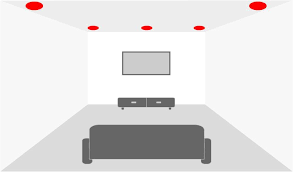Can surround speakers be placed in the ceiling?
Yes they can and most times it is a very good thing if you want to really experience the depth of the music you are playing.
While this is a generally good practice to carry out, there are a couple of things that you need to be aware of when doing this.
If you are planning to buy and fix new surround speakers in your home, doing it yourself can be a good move.
It lets you save money and at the same time, you also get some real world experience on how to go about it.
In this article, I will be showing you a step by step guide to how you can easily place surround speakers in the ceiling of your house.
How to place your surround speakers for the best sound

If you are just starting out, regardless of the number of surround speakers that you have, the final goal is always the same
And this is to get precise localization of special effects, a spacious sound stage, seamless panning across all channels and 3 dimensional imaging.
This can only be achieved if each speaker is placed properly.
Here is an article I wrote showing you the best speakers for bedroom.
And also you want to make sure you have a clear plan of action before you begin
Surround speaker placement for background music
If you are planning a surround speakers system mainly for background music, you want to aim for balanced sound throughout your space.
One thing I take note of is that it is always better to have too many speakers than too few.
If the speakers are too far apart, then you will have music playing at different sound levels in most parts of the house.
Thinking of getting speakers for your apartment? Here is an article I wrote showing the best speakers for apartments
5.1 Surround Sound Speaker Placement
When placing your speakers for your 5.1 Home Theater, here are the key points to note
Front Left/Right Mains Speakers
The main speakers should be placed 25-30 degrees off-axis, relative to the primary seating position.
The best imaging will be obtained when the tweeters are close to ear height when seated.
Most tower speakers accomplish this naturally, and a bookshelf monitor will require stands.
Pulling the main speakers away from the corners (to the extent allowed by room traffic) will reduce boundary reflections and improve imaging.
Center Channel Speaker
The center channel should be placed directly on-axis, relative to the primary seating position.
As with the main front speakers, placing the tweeter at/near head level when seated is optimal.
But depending on the placement of the video display or projection screen, this is not always possible.
If the center channel must be located below head level, then an upward tilt of the speaker is recommended to improve mid/high frequency response and dialogue intelligibility.
Side Surround Speakers
In a 5-channel system, the side surround speakers should be located 90-110 degrees off-axis. For the best sense of spaciousness, the tweeter height should be about 2 feet above ear level.
Rear Surround Speakers
In a 7.1 system, dedicated rear surround speakers are placed behind the primary seating position for enhanced rear panning effects.
Place the rear surround speakers at 135-150 degrees off-axis, relative to the primary seating position. As with the side surround speakers, position the rear surround tweeters about 2 feet above head level when seated.
7.1 surround Speaker Placement sound
In a 7.1 system, surround speakers are positioned beside and behind your seating area.
Just like in a 5.1 setup, the side speakers are placed to the left and right of your seating position and face directly towards you.
The rear speakers are positioned behind you, facing forward.
Position both pairs of speakers one to two feet above ear level for best performance.
How to properly place your Subwoofers
Your subwoofers are the things that make or break your sound
Think of them as the cool guy in high school who goes wherever he wants and follows nobody’s rule.
The main reason for this is the subwoofer has a very specific job – to reproduce the really low bass in a soundtrack.
Low bass frequencies are not as directional as higher frequencies due to their long wavelength. This means that it is harder to tell where the sound is coming from in the room.
Therefore, subwoofer placement in a room is much less critical than with other speakers – which can be a blessing given the size of the darn thing!
Wherever you have a spare bit of space in your room then you can pretty much stick it anywhere.
Although, there are a few general guidelines worth considering if you can.
Basically you want to avoid corners when placing your subwoofers as this can produce a “boomy” sound and reduces the clarity of your sound.
Also you can use the position of corners around the room to your advantage and really boost bass sound from your subwoofer.
Another thing is to have a go at different positions around your apartment and see what works for you.
One thing to listen out for is areas of the room where the bass is especially quiet – or loud.
Because of the long wavelength of bass sound waves, it is easy to create standing waves in a room.
Tips to help you in making sure you get the best speaker placement
1. Every room is different.
This is perhaps the most important tip to keep in mind.
Most of us will be using a communal living area for our home theater equipment, and so it is very difficult to get the perfect setup.
However, that doesn’t mean that we can’t try to get the best sound possible from our amplifier and speakers.
While you may not be able to get every point exactly right, you will still be making the best use of the space you have available.
Most people will have to make some compromises in their location of their speakers.
That’s fine, just aim to do the best job you can. It will make a big difference to the sound in your room.
2. Avoid setting up your speakers very close to corners, walls and ceilings
3. Avoids obstructions

